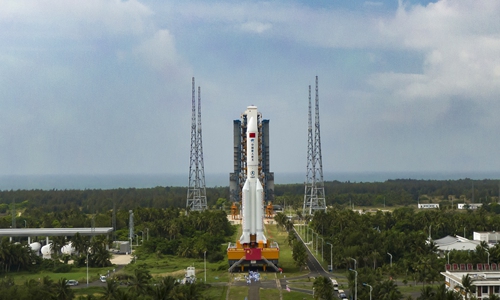Tiangong details unveiled
Source:Xinhua Published: 2020/5/21 21:08:40
China’s space station to be completed around 2022

The Long March-5B launch vehicle at Wenchang Space Launch Center on the coast of South China's Hainan Province. Photo: cnsphoto
After the successful maiden flight of the Long March-5B large rocket and the testing of China's new-generation manned spaceship, more details of China's space station have been unveiled.
The space station, expected to be completed around 2022, will operate in low-Earth orbit at an altitude of 340 kilometers to 450 kilometers for more than 10 years, supporting large-scale scientific, technological and application experiments, according to a report in the People's Daily.
What will it look like?
The space station Tiangong, meaning Heavenly Palace, will be able to accommodate three astronauts in normal circumstances and up to six during a crew replacement.
The station will be a T shape with the core module at the center and a lab capsule on each side. Each of the modules will be over 20 tons, with the total mass of the station about 66 tons, said Zhou Jianping, chief designer of China's manned space program.
If China's Tiangong-1 and Tiangong-2 space labs are like one-bedroom apartments, the space station is equivalent to an apartment with three bedrooms, a living room, a dining room and a storage room, said Zhu Guangchen, deputy chief designer of the space station from the China Academy of Space Technology (CAST).
The core module of the station, Tianhe, has a total length of 16.6 meters, a maximum diameter of 4.2 meters and a takeoff mass of 22.5 tons, and is currently the largest spacecraft developed by China.
The living space in the Tianhe core module is about 50 cubic meters. Combined with the two lab capsules, the whole living space could be up to 110 cubic meters, according to CAST.
The core module has two berth ports connecting to the two lab capsules, and three docking ports for the crew spacecraft, cargo and other craft. The first lab capsule, Wentian, will be mainly used for scientific and technological experiments, as well as working and living space and shelter in emergency. This capsule is equipped with a special airlock chamber to support extravehicular activities and a small mechanical arm for the automatic installation and operation of extravehicular instruments. It can manage and control the space station if needed, according to CAST.
The second lab capsule, Mengtian, has functions similar to the first. It is equipped with a special airlock chamber to support the entry and exit of cargo and instruments with the help of astronauts and mechanical arms.
The Long March-2F carrier rocket and Shenzhou manned spacecraft will be used to transport crew and some materials between Earth and the space station. The Shenzhou can carry three astronauts and be used as a rescue spacecraft in emergency.
The Long March-7 rocket and Tianzhou cargo spacecraft will be used to transport materials, propellants and instruments for the station.
The Long March-5B rocket will carry the core module and lab capsules into space, as well as a capsule holding a 2-meter-caliber optical telescope, which will fly in the same orbit as the space station.
The telescope capsule Xuntian is expected to provide observation data for astronomical and physical studies to help scientists better understand the universe. During its expected 10-year operation, it will be able to observe over 40 percent of the sky, said Zhou.
How will it be constructed?
Twelve flight missions are planned to construct the station. After the maiden flight of the Long March-5B, the core module and the two lab capsules will be launched for assembly in orbit. Four manned and four cargo craft will also be launched, said Lin Xiqiang, deputy director of the China Manned Space Agency (CMSA).
China will face great challenges and complexities in the coming high-density launch missions, said Zhou Jianping.
Chinese astronauts will shoulder many tasks in the construction of the space station. They will conduct many complex extravehicular tasks, and work with mechanical arms to complete the installation, testing, adjustment and upgrading of the payloads in orbit.
One astronaut can operate the mechanical arm inside the capsule while another works outside. The space station will have two kinds of mechanical arms, said Zhou.
Because of the high cost of transporting materials into space, the ability to recycle as much as possible is a major technological issue, Zhou said.
The longest stay in space so far by Chinese astronauts is 33 days. The water and oxygen they needed were taken into space. To enable astronauts to stay longer, the station will be equipped with a renewable life support system. The hydrogen produced in electrolytic oxygen production and the carbon dioxide exhaled by astronauts can generate oxygen through a chemical reaction.
The power system includes two pairs of flexible solar panels, with each panel about 30 meters long. The station will also use electric propulsion technology to maintain its course.
Scientific experiments
Scientific facilities on the station could support hundreds of research projects in fields such as astronomy, biotechnology, microgravity, basic physics and space materials.
More than a dozen advanced experiment racks will be installed, and an extravehicular experiment platform will be built. Each rack is regarded as a lab that can support various space experiments.
Scientists will also conduct space life science and biotechnology experiments on the station to study how human beings might live in space for long periods.
The station's construction crew has been selected and is being trained. China's third group of reserve astronauts will be selected around July, according to CMSA.
Posted in: INDUSTRIES